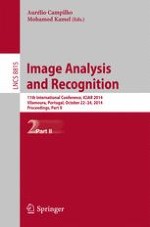The two volumes LNCS 8814 and 8815 constitute the thoroughly refereed proceedings of the 11th International Conference on Image Analysis and Recognition, ICIAR 2014, held in Vilamoura, Portugal, in October 2014. The 107 revised full papers presented were carefully reviewed and selected from 177 submissions. The papers are organized in the following topical sections: image representation and models; sparse representation; image restoration and enhancement; feature detection and image segmentation; classification and learning methods; document image analysis; image and video retrieval; remote sensing; applications; action, gestures and audio-visual recognition; biometrics; medical image processing and analysis; medical image segmentation; computer-aided diagnosis; retinal image analysis; 3D imaging; motion analysis and tracking; and robot vision.
